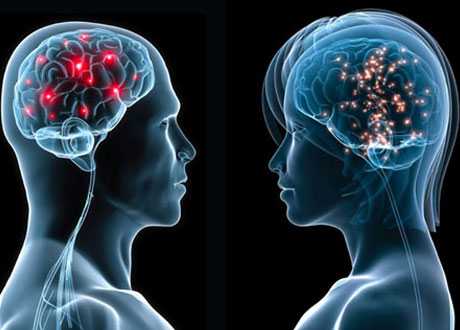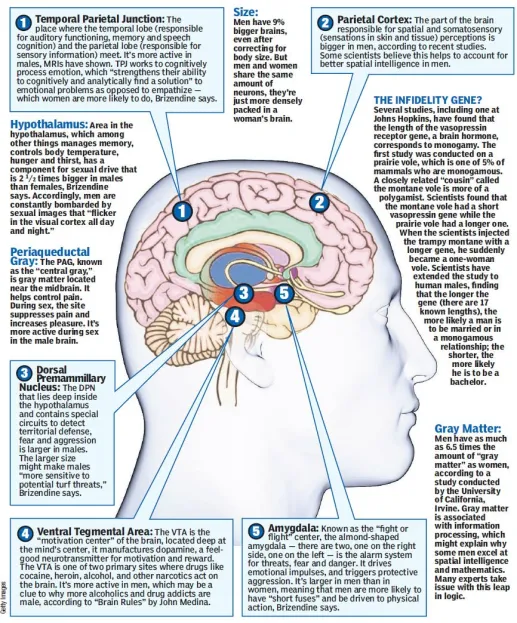Male Brain 🧠 versus Female Brain 🧠
🧠
FEMALE BRAIN
Prefrontal Cortex
Considered the “CEO of the brain,” the PFC makes decisions and inhibits rash behavior. It’s where we process anger, fear, and aggression. It’s larger in women and matures a full two years before men, usually by the early 20s. Because women have larger prefrontal cortexes, they may be less easy to make angry, Brizendine says.
Frontal Cortex
Responsible for much of our decision making ability, it is fatter and more complex in women. Some neuroscientists believe that women are hard-wired to be better decision-makers and problem-solvers.
Anterior Cingulate Cortex
The source of women’s “gut feelings” is larger in women. It weighs options, detects conflicts, motivates decisions, and is known as the area of self-consciousness.
Insular Cortex
The insula is a portion of the cerebral cortex that processes gut feelings and is larger is women. “The relationship between a woman’s gut feeling and her intuitive hunches is grounded in biology,” Brizendine says.
Hippocampus
The brain’s memory center that turns short-term memories into long-term ones. It’s larger in women than in men. Women have an often better memory for details, both pleasant and unpleasant, Brizendine says. “It’s the elephant that never forgets a fight, a romantic encounter or a tender moment — and won’t let you either.”
Amygdala
When women were showed a horror film, their left-side amygdala (they have two), which pays attention to detail and internal thought, lit up. When men saw the same slasher flick, their right side was activated, which is associated with action and external environment. Scientists believe this may account for why men are more likely to respond with their fists when attacked or threatened.
Mirror-Neuron System
It’s when neurons in the brain fire when a person experiences an event and when she observes an action. Known as the body’s “empathy” system, which enables a person to “feel” the pain of others. Used in understanding the action of other people, language acquisition through imitation, and the “I know how you feel” sentiment. It’s larger and more active in females, according to a recent study conducted by Dr. Ya-Wei Cheng, a Taiwanese neuroscientist.
Limbic Cortex
Part of the limbic system, responsible for regulating emotion, is larger in women. Scientists say that many women are better able to express emotion because of this. Having larger limbic cortexes, however, make females more likely to suffer from depression, doctors say.
White Matter
Women are thought to have 10 times the amount of “white matter” than men. White matter works to network or connect different processing centers of the brain, making a female more efficient in multi-tasking skills. Some researchers believe that it might play a role in why women often excel at language and verbal skills. But, like the gray matter hypothesis, these are controversial conclusion.
Neuroscientists have found that women’s brains often have stronger connections between the hemispheres. Research conducted by Indiana University School of Medicine showed that women use both sides of their brain while listening, while men only used one side. This may suggest why women are considered better listeners.

🧠
MALE BRAIN
Temporal Parietal Junction
The place where the temporal lobe (responsible for auditory functioning, memory and speech cognition) and the parietal lobe (responsible for sensory information) meet. It is more active in males, MRI’s have shown. TPJ works to cognitively process emotion, which strengthens their ability to cognitively and analytically find a solution to emotional problems as opposed to empathize – which women are more likely to do, says Louann Brizendine (author of The Female Brain).
Size
Men have 9% bigger brains, even after correcting for body size. But men and women share the same amount of neurons, they’re just more densely packed in a woman’s brain.
Gray Matter
Men have as much as 6.5 times the amount of “gray matter” as women, according to a study conducted by the University of California, Irvine. Gray matter is associated with information processing, which might explain why some men excel at spatial intelligence and mathematics. Many experts take issue with this leap in logic.
The infidelity gene?
Several studies, including one at Johns Hopkins, have found that the length of the vasopressin receptor gene, a brain hormone, corresponds to monogamy. The first study was conducted on a prairie vole, which is one of 5% of mammals who are monogamous. A closely related “cousin” called the montane vole is more of a polygamist. Scientists found that the montane vole had a short vasopressin gene while the prairie vole had a longer one. When the scientists injected the trampy montane with a longer gene, he suddenly became a one-woman vole. Scientists have extended the study to human males, finding that the longer the gene (there are 17 known lengths), the more likely a man is to be married or in a monogamous relationship; the shorter, the more likely he is to be a bachelor.
Parietal Cortex
The part of the brain responsible for spatial and somatosensory (sensations in skin and tissue) perceptions is bigger in men, according to recent studies. Some scientists believe this helps to account for better spatial intelligence in men.
Hypothalamus
Area in the hypothalamus, which among other things manages memory, controls body temperature, hunger and thirst, has a component for sexual drive that is 2 1/2 times bigger in males than females, Brizendine says. Accordingly, men are constantly bombarded by sexual images that “flicker in the visual cortex all day and night.”
Periaqueductal Gray
The PAG, known as the “central gray,” is gray matter located near the midbrain. It helps control pain. During sex, the site suppresses pain and increases pleasure. It’s more active during sex in the male brain.
Ventral Tegmental Area
The VTA is the “motivation center” of the brain, located deep at the mind’s center. It manufactures dopamine, a feel-good neurotransmitter for motivation and reward. The VTA is one of two primary sites where drugs like cocaine, heroin and other narcotics act on the brain. It’s more active in men, which may be a clue to why more alcoholics and drug addicts are male, acording to Brain Rules by John Medina.
Amygdala
Known as the “fight or flight” center, the almond-shaped amygdala – there are two, one on the right side, one on the left – is the alarm system for threats, fear and danger. It drives emotional impulses, and triggers protective aggression. It’s larger in men than in women, meaning that men are more likely to have “short fuses” and be driven to physical action, Brizendine says.
Dorsal Premammillary Nucleus
The DPN that lies deep inside the hypothalamus and contains special circuits to detect territorial defense, fear and aggresion is larger in males. The larger size might make males “more sensitive to potential turf threats”, Brizendine says.


